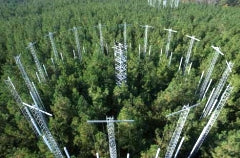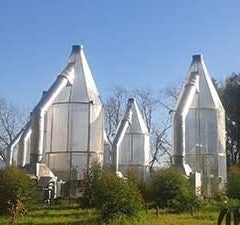Guest post by Michael Forster, Edaphic Scientific Pty Ltd
Everyone knows that plants need carbon dioxide to grow. But fewer people know that carbon dioxide can also effect plant transpiration and even the water balance of entire ecosystems and catchments. Even fewer people know that carbon dioxide can affect biodiversity and which plant species are more common than other species.
Let’s just leave aside all of the topics on how increasing carbon dioxide is leading to global warming and how this, in turn, is impacting on plant species. Let’s just focus purely on how increasing atmospheric carbon dioxide changes the fundamental physiology of plants and how this, in turn, can lead to changes in transpiration and which species are more common in a forest.
Firstly, how do we know all of this? Scientists have been conducting experiments for years now where they have artificially increased atmospheric carbon dioxide around plants and forests.

They do this via experiments called FACE – or Free Air Carbon Enrichment – where massive towers gorge out copious amounts of CO2. Image: FACE experiment at Duke University, North Carolina, USA (source: https://www.czen.org/content/duke-forest-face-experiment)

What these experiments have generally shown is that plants actually like it when there is more carbon dioxide in the atmosphere. Plants generally grow larger and faster with more CO2. The process is similar to when you add fertilizer to the soil to assist the plant’s growth. Instead, we are adding fertilizer to the atmosphere in the form of more carbon dioxide. As there is more carbon dioxide in the atmosphere, it is generally easier for plants to perform photosynthesis and accumulate biomass.
In terms of transpiration, or plant water use, an increase in atmospheric CO2 means that stomata, or the pores on leaves that exchange gases between the leaf and the atmosphere, do not need to open as much. This means that, at the scale of a leaf, less water is lost and there is lower transpiration. With increased photosynthesis and lower water loss, then the water efficiency of plants is increased.
So it seems that more carbon dioxide in the atmosphere is a good thing for plants – they grow faster and use less water. However, nothing in biology is so simple. Yes the water loss at the scale of a leaf is lower, however, there are more leaves on the plant because it is growing faster and bigger. So, at the scale of the entire plant, water use or transpiration is actually higher.
This may seem trivial but consider this: a 30 metre (100 foot) tall tree transpires about 200 litres (53 gallons) on a good day. A forest of woodland contains many thousands to millions of individual trees all transpiring about 200 litres per day. This can impact on water reserves – particularly around dams for drinking water or irrigation. With increased atmospheric carbon dioxide, all of those trees may potentially transpire more water and having a greater impact on water supplies.
Also, not all species of plants are created equally. Increasing carbon dioxide does improve growth but some species perform better than others. In a woodland or rainforest, some species may grow better and out compete their neighboring plants. That is, some species may become more common and others scarce. This may then impact on the animals that rely on those plants for food and shelter.
Increasing atmospheric carbon dioxide can benefit plants – something greenhouse and glasshouse growers use to their advantage. However, the process and outcomes are complex. In the real world increasing carbon dioxide does not benefit all plants.







